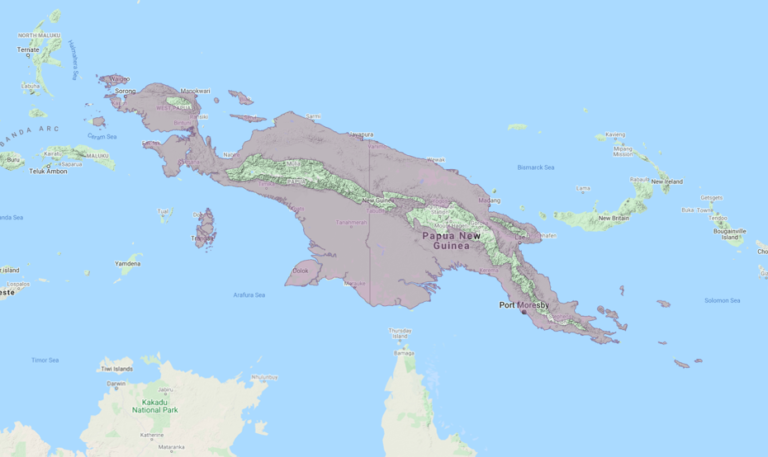Birdfinding.info ⇒ The New Guinean form of Sulphur-crested Cockatoo remains widespread and locally common across much of New Guinea and many adjacent islands. Sites where it has been found consistently include the Hiritano Highway near Port Moresby, Varirata National Park, the Kiunga area, and the hills above Madang. The introduced Palau population (thought to be this form) is common in the Rock Islands and the southern tip of Babeldaob.
“Triton Cockatoo”
Cacatua galerita triton
Endemic to New Guinea and adjacent islands: Waigeo, Gam, Kofiau, Misool, Batanta, Salawati, Numfoor, Biak, Num, Japen, the Trobriand Islands, Goodenough, Fergusson, Normanby, and the Louisiade Archipelago.
Predominantly in humid lowland and foothill forests but reportedly also occurs in some savannas and other semiopen habitats, and in mountains up to around 2,000 m elevation.
The potentially distinguishable subspecies eleonora is native to the Aru Islands south of western New Guinea, and has reportedly been introduced to the nearby Kai Islands.
A well-established introduced population of Sulphur-crested Cockatoos in Palau has been ascribed to triton, but this identification does not appear to be independently verifiable from publicly available source materials.
Identification
A mid-sized white cockatoo with a yellow crest, roughly intermediate in size between typical Sulphur-crested and Yellow-crested Cockatoos—and differs from both in often having bluish orbital skin.

“Triton Cockatoo”, C. g. triton—note that even at very close range the orbital skin color can appear white. (Kaibola, Kiriwina Island, Papua New Guinea; October 1, 2018.) © Simon Nicholas
Compared to the much more familiar Australian populations of Sulphur-crested, “Triton” gives the impression of a smaller bird—proportioned differently, with a large bill and large head, closer to the proportions of a typical Yellow-crested.
(For a detailed comparison of the several similar forms in this complex, see Identification of Yellow-crested Cockatoos.)
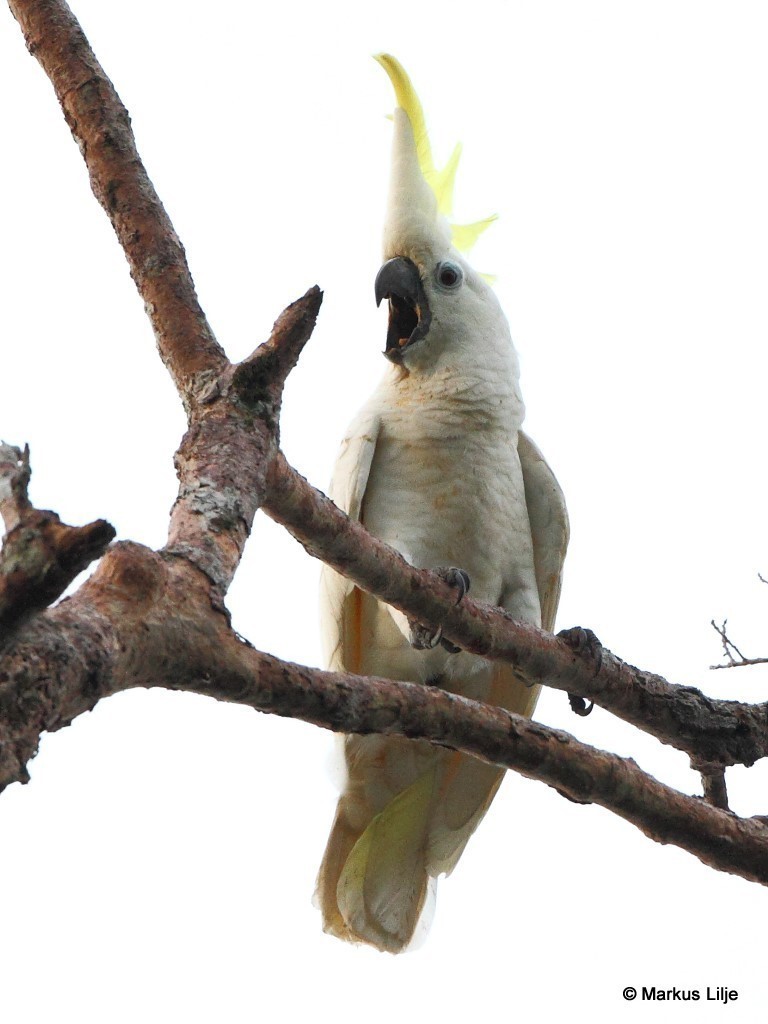
“Triton Cockatoo”, C. g. triton, vocalizing, with crest fully extended—its normally-white body plumage is discolored. (Fly River, Papua New Guinea; August 2, 2013.) © Markus Lilje
When seen at close range in optimal lighting, the orbital skin typically appears pale powder-blue (see photos of captive individuals below), but this coloration varies, and it often appears either white or very subtly bluish-white—not reliable for field identification.
The crest is essentially identical to that of other Sulphur-crested and Yellow-crested populations: the frontal feathers are white, and the middle and hind-crown feathers are pale-yellow, long, and up-curved—so their tips point forward when the crest is raised. At rest, the white shield partly obscures the yellow feathers.
As in other white cockatoos, the undersides of the wings and tail are suffused with yellow.
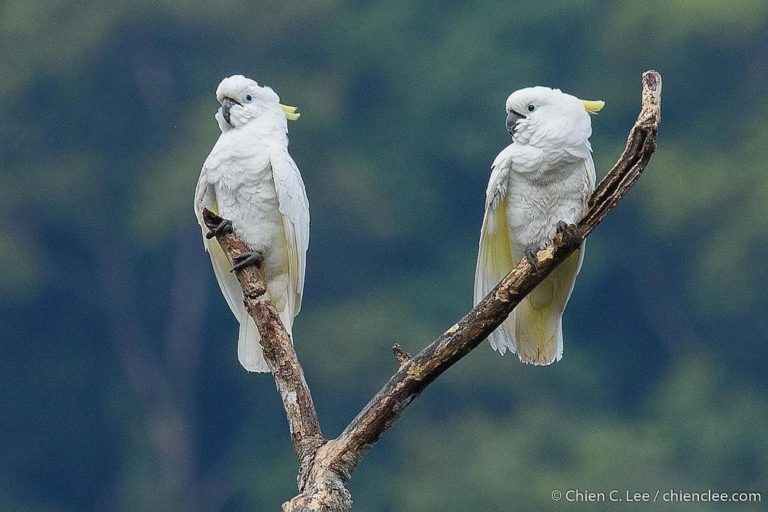
“Triton Cockatoo”, C. g. triton, pair, showing that the bluish orbital skin is not a conspicuous field mark, and often unreliable for field identification. (Manokwari, West Papua, Indonesia; August 14, 2015.) © Chien C. Lee
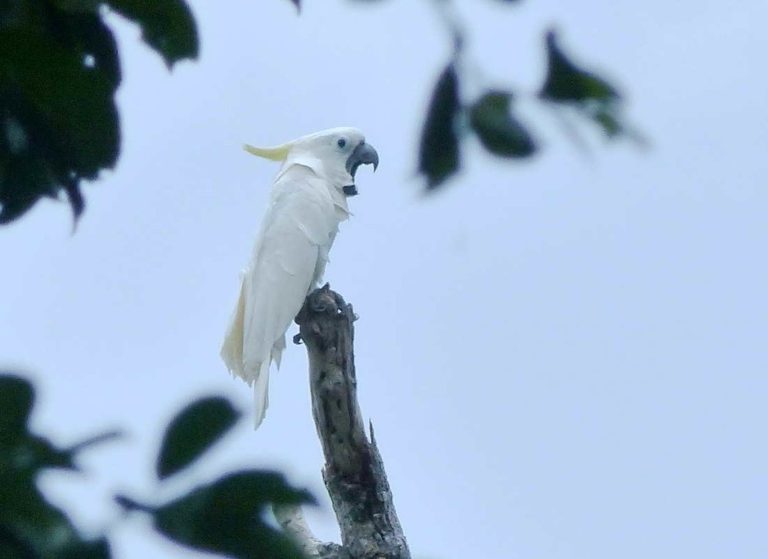
“Triton Cockatoo”, C. g. triton, vocalizing—note the proportionately big-headed, big-billed appearance. (Sapokreng, Waigeo, West Papua, Indonesia; October 29, 2017.) © Benoit Segerer

“Triton Cockatoo”, C. g. triton, ventral view in flight, showing yellowish wash on the undersides of the wings and tail. (Keki Lodge, Madang, Papua New Guinea; July 15, 2014.) © Lars Petersson
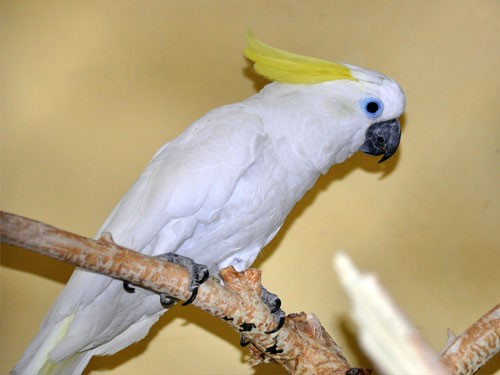
“Triton Cockatoo”, C. g. triton, close-up view of a captive individual, showing vivid powder-blue orbital skin. (Grodno Zoo.) © Zoo Institutes
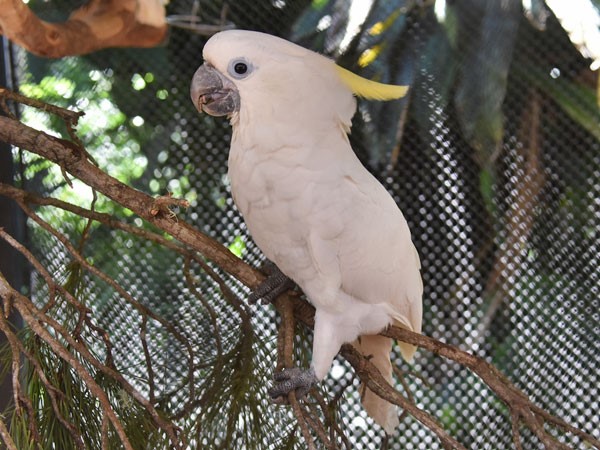
“Triton Cockatoo”, C. g. triton, close-up view of a captive individual, showing subtly bluish orbital skin. (Loro Parque.) © Zoo Institutes
Voice. Most typical calls are harsh, wailing screeches (apparently less harsh, more mournful than Australian populations of Sulphur-crested):
Notes
Polytypic form consisting of two recognized subspecies—triton and eleonora—collectively one of two potentially distinct forms of Sulphur-crested Cockatoo (Cacatua galerita).
Aviculturists often regard the name “Triton Cockatoo” as synonymous with the subspecies triton and adopt the name “Eleonora Cockatoo” to refer to the subspecies eleonora, but the two seem to be effectively indistinguishable.
References
BirdLife International. 2018. Cacatua galerita. The IUCN Red List of Threatened Species 2018: e.T22684781A131914971. https://dx.doi.org/10.2305/IUCN.UK.2018-2.RLTS.T22684781A131914971.en. (Accessed August 25, 2021.)
eBird. 2021. eBird: An online database of bird distribution and abundance. Cornell Lab of Ornithology, Ithaca, N.Y. http://www.ebird.org. (Accessed August 25, 2021.)
Forshaw, J.M. 2010. Parrots of the World. Princeton University Press.
Juniper, T., and M. Parr. 1998. Parrots: A Guide to Parrots of the World. Yale University Press.
Xeno-Canto. 2021. Sulphur-crested Cockatoo – Cacatua galerita. https://www.xeno-canto.org/species/Cacatua-galerita. (Accessed August 25, 2021.)

